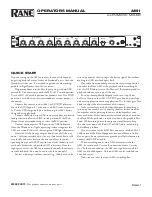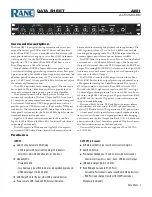
20
Names of things and what they do
The overall flow of audio signals in the M-16DX is shown in the following diagram. For a more detailed illustration of signal flow,
refer to “Block diagram” (p. 10).
fig.02-SignalFlow
MULTIPLE INPUT
These are the input channels that receive audio signals from
external devices.
This includes mic inputs, line inputs, and digital input
(optical/coaxial), and also allows you to receive digital audio
signals via USB.
BUS
A “bus” is a signal route to which multiple signals within the
mixer are combined.
There are four buses—MAIN, ALT, AUX, and SOLO—and the
signals combined to each bus are sent to the corresponding
output route.
MAIN OUT
This is the output route for signals sent from the MAIN bus.
ALT OUT
This is the output route for signals sent from the ALT bus. You
can also send these signals to the MAIN bus by making the
appropriate setting on the mix controller.
AUX SEND
This is the output route for signals sent from the AUX bus.
PHONES/CONTROL ROOM
This is the output route used to monitor the signals of MAIN
OUT and ALT OUT. By making the appropriate setting on the
mix controller, you can switch this to the output route for
signals sent from the SOLO bus.
USB
Signals can be received from a USB-connected computer or
sent to the computer.
Signals from the computer are input to channels 13/14. From
the M-16DX, the pre-fader signals of all input channels, as
well as the signal following the MAIN MIX LEVEL knob are
sent to the computer.
Signal flow
B
U
S
AUX SEND
PHONES /
CONTROL ROOM
MAIN OUT
ALT OUT
USB
MULTIPLE INPUT
1–16
Содержание Edirol M-16DX
Страница 10: ...10 Block diagram ...
Страница 11: ...11 ...
Страница 58: ...58 For EU Countries GR SK CZ SI LV LT EE PL HU FI SE NO DK NL PT ES IT DE FR UK ...
Страница 60: ...04561878 2MP ...
















































